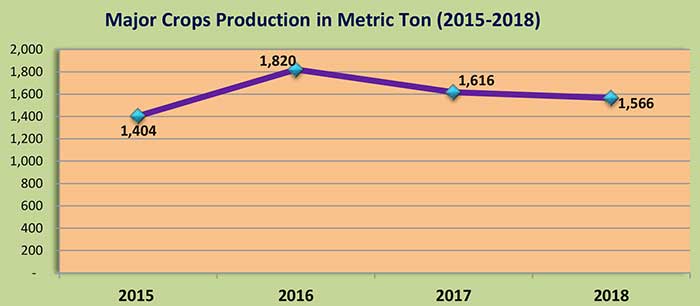Thinley Namgay
When the agriculture ministry asked residents in Thimphu last month to apply for land to cultivate vegetables, many got together to form groups. The scheme could not materialise.
But there is no dearth of fallow land or space to grow crops in Thimphu dzongkhag.
Of the eight gewogs under Thimphu, a total of 238.10 acres of dry land and 19.50 acres of wetland have remained fallow in five gewogs, excluding the highland gewogs of Soe, Naro, and Lingzhi.
One of the nearest gewogs to Thimphu city, Genekha has the most fallow land with 151.50 acres of dry land and 7.85 acres of wetland. Just to the north of the town, Kawang gewog, which includes Kabisa area, has the second-largest amount of fallow land with 33.45 acres of dry land and 11.65 acres of wetland, according to records with Thimphu dzongkhag.
As per the Thimphu plan review for the Covid-19, the other gewogs with fallow land are Chang, Mewang, and Dagala.

Major crops (paddy, wheat, barley) production in metric tonnes (2015-2018)
Crop production and acreage of land use in the dzongkhag generally marked a gradual decline in recent years. For instance, a major cereal grown in the dzongkhag, paddy has dropped both in terms of acreage and production. From 632 acres producing 1,490 metric tonnes in 2016, paddy production fell to 1,323MT from 579 acres.
Similarly, the area for wheat and barley production reduced from 261 acres and 25 acres to 199 acres and 15 acres respectively. The three crops together recorded a fall from 1,820MT in 2016 to 1,566MT in 2018.
The dzongkhag has a poverty rate of 1.1 percent according to the Bhutan Poverty Analysis report 2017.
Thimphu Dzongkhag’s Agriculture Officer (DAO), Sonam Zangpo, said that the dzongkhag has been helping the communities to carry out commercial agriculture. “The fallow lands belonging to private individuals and institutions are favourable for farming, but these areas have remained fallow for many years.”
Sonam Zangpo said the main reason for fallow land was the shortage of farm labour. “With development, youths tend to move to urban areas, and only old people remain in the villages. They prefer other works compared to agriculture.”
“The land fragmentation and cheap agriculture produce from across the border are other factors.”
“Farmland gets divided among children. But only a few children stay in a village, and the land becomes fallow. Due to the economic opportunity in other sectors, people don’t stay in a village.”
Sonam Zangpo said that the government has been developing land to encourage mechanised farming. “The government is spending on land development, for instance making terraces on sloppy fields which are not suitable for cultivation and also widening the small terrace. Irrigation canals are also maintained.”
He said that Farm Machinery Corporation has been deploying power tillers and tractors with nominal hiring charges to help those farmers who don’t own machinery. Of the 118 power tillers in the dzongkhag, private individuals own 103, and the rest belongs to the government.
To control the human-wildlife conflict, the dzongkhag continuous to invest in installing electric fencing. Today, there are 141km of electric fencing, in 2016 the dzongkhag had 47km.
Genekha Gup Karma Gyeltshen said that despite various initiatives by the government, not many are interested in farming.
“Of the five chiwogs in my gewog, three chiwogs have favourable climatic conditions to grow all kinds of fruits and vegetables. But only a few households do.”
He said that the Covid-19 situation had reignited the interest in large scale farming in villagers.
There are around 250 households and more than 1,500 people in Genekha gewog.
The dzongkhag has a registered population of 24,185.

